|
|
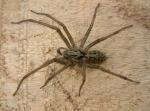
|
House Spider
|
|
Special features: This is one of about a dozen species which inhabit houses and outbuildings - hence the common name house spiders. |
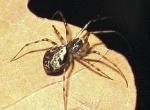
|
Invisible Spider
|
|
Special features: Invisible spiders get their name from their ability to hide themselves so well. When you find them they're usually on the bark of trees, but they're not always visible until they move. |
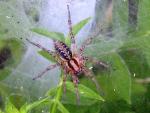
|
Labyrinth
|
|
Special features: The abdomen of the labyrinth spider features a central pale brown stripe with a darker, more greyish band on either side. The darker bands have tiny white dashes or chevron markings running through them. |
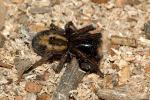
|
Lace Webbed Spider
|
|
Special features: This is one of two very similar species of spider - hence the name similis. If you find one in a house it is likely to be Amaurobius similis. If you find one in a garden or outdoors it is likely to be Amaurobius fenestralis |
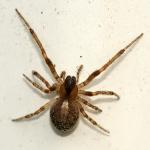
|
Missing Sector Spider
|
|
Special features: The Missing Sector spider has a silver-grey coloured abdomen with a brown oak leaf pattern on the back. The legs dark brown with light brown bands. |
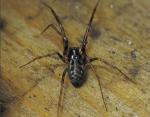
|
Money Spider
|
|
Special features: Despite its specific name 'minutus' is one of the largest money spiders, or which there are around 20 species (though recent taxonomic work suggests the genus should be split into smaller groups). |
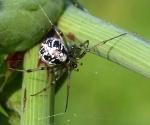
|
Mothercare Spider
|
|
Special features: The Mothercare spider has a very rounded abdomen which has distinctive black and white markings on the back and some orange-brown streaks on the underside. |
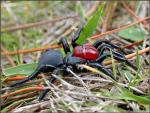
|
Mouse Spider
|
|
Special features: The mouse spider gets its name from the grey coloured abdomen which is covered in tiny hairs and resembles mouse fur. |
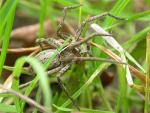
|
Nursery Web Spider
|
|
Special features: Nursery web spiders are narrow bodied and can be grey or brown in colour. There is a pale stripe just behind the head, and the sides of the abdomen are also pale coloured. The top of the abdomen features a leaf shaped marking. |
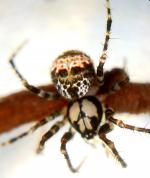
|
Pirate Spider
|
|
Special features: If you look closely you'll see this spider has a patch over one its eyes. |
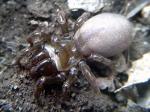
|
Purse Web Spider
|
|
Special features: Purse Web Spiders are a dark brown colour, with greyish-white lines where the jaws meet the carapace. The carapace is very square at the front, and the legs are stocky. The abdomen in the female is generally larger than in the male, and more pale in colour. |

|
Rabbit Hutch Spider
|
|
Special features: Steatoda bipunctata is one of the spiders commonly known as a false widow spider. It's also sometimes referred to as the Rabbit Hutch Spiders as they're often found inside rabbit hutches. They're usually chestnut coloured, although some specimens can be lighter in colour. Frequently there is a line of tiny cream coloured dots running around the midline of the abdomen. |
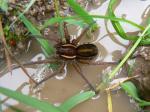
|
Raft Spider
|
|
Special features: Sometimes called the Fishing Spider or Fen Spider. The Raft Spider sits at the edge of pools with its front legs resting on the surface of the water. From this position it can detect the vibrations made by any small creatures as they touch the water. Using the surface tension of the water it can run across the surface to catch its prey. |
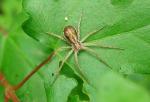
|
Running Crab Spider
|
|
Special features: The palps are quite large. Looks like it's wearing a pair of boxing gloves. |
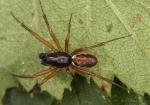
|
Sheetweb Spider
|
|
Special features: Sheetweb Spiders, sometimes called Hammock Spiders, have a dark brown body with variable cream coloured markings arranged in a broken band around the abdomen. The legs are all one colour (no banding). |

|
Snake-back Spider
|
|
Special features: Snake-back Spiders get their name from the row of dark coloured patches on their elongated abdomens which resemble the markings on some poisonous snakes, such as the adder. Another common name is Leopard Spider, for the same reason. |
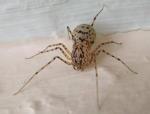
|
Spitting Spider
|
|
Special features: Spitting spiders are a pale brown colour and covered with small chocolate brown spots. The front half of the spider is dome shaped to house its enlarged venom glands. It has three pairs of eyes. The males and females look very similar. |
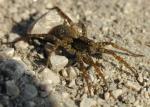
|
Spotted Wolf Spider
|
|
Special features: These wolf spiders are often active very early in the spring. They can be seen scurrying around hunting for prey and warming themselves in the sunshine on patches of bare soil. Unlike spiders who use a web to catch their food, these wolf spiders catch their prey by running it down. |
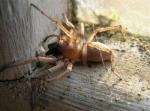
|
Stone Spider
|
|
Special features: Stone Spiders are so called because they're nearly always found under stones. The body varies in colour from pale brown to grey. The four long tubular spinnerets at the rear of the abdomen are a distinguishing feature. |

|
Stripe-legged Spider
|
|
Special features: As the name suggests, it has distinctive brown stripes on its legs. This six-eyed spider is in the same family as the woodlouse spider, and always looks exactly the same, whether a tiny spiderling or adult. |

|
Tetragnatha Extensa
|
|
Special features: The body colour can vary from creamy-yellow (as above) to green. When alarmed, it stretches its long legs out straight along a branch, in an effort to disguise itself. |
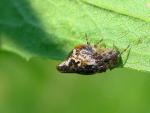
|
Trashline Spider
|
|
Special features: Trashline Spiders get their name from the way they strap food items and waste in a thick silk line running through their webs from top to bottom. This 'trash' probably helps to disguise the spider when it's sitting in the centre of the web. |
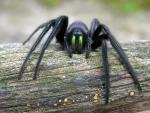
|
Tube Web Spider
|
|
Special features: By UK standards the tube web spider is a large spider. It is nocturnal, and has six eyes arranged in three groups of two. |
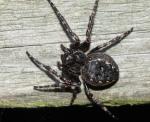
|
Walnut Orb-weaver
|
|
Special features: The Walnut Orb-weaver is a fairly common garden spider. It is dark coloured, with a shiny, pill-shaped abdomen. The female Walnut Orb-weaver has a larger, more rounded abdomen. The male is slimmer and has distinctive rounded palps. Both the male and female have a brown, oak leaf shaped marking on the abdomen. |
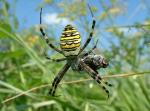
|
Wasp Spider
|
|
Special features: This is one of our more exotic looking spiders. It's a native spider of Mediterranean areas, and has only recently colonised England. Despite the warning colouration this is not a dangerous species. The wasp-like appearance is probably defensive, to deter predators. |
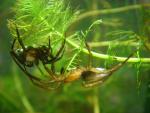
|
Water Spider
|
|
Special features: Water spiders are a brown colour with a grey-brown abdomen. When underwater the hairy abdomen appears silver due to air caught in the hairs. |
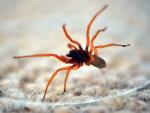
|
Woodlouse Spider
|
|
Special features: The woodlouse spider has a body which can vary in colour from creamy-grey to red-brown. |
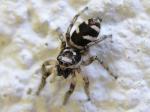
|
Zebra Spider
|
|
Special features: Zebra spiders are so called because of the black and white stripes on their abdomen. The males differ from the females in having large forward pointing black fangs. |
|
|